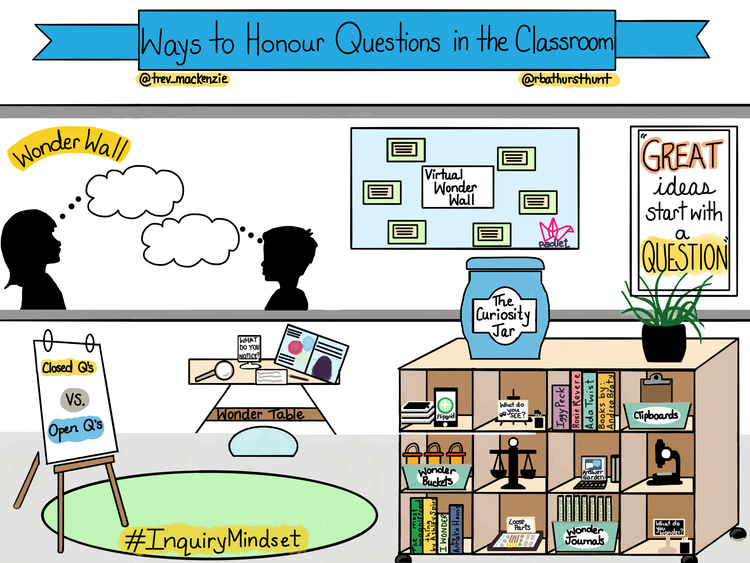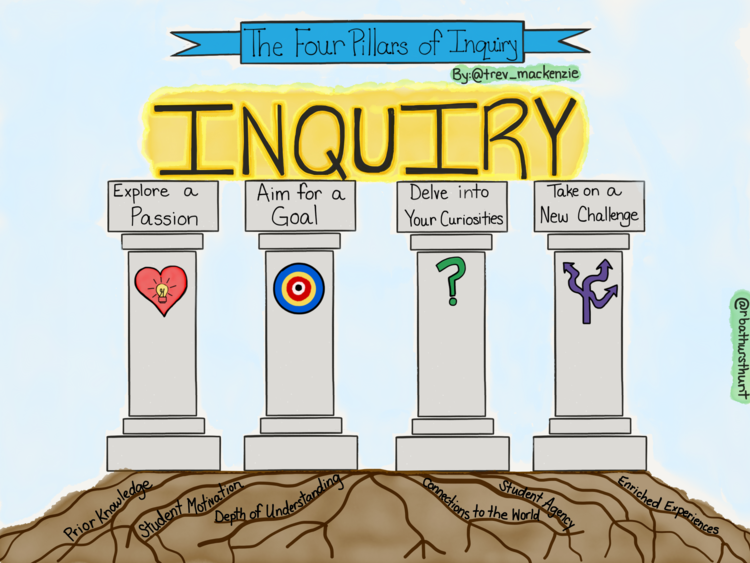Trevor Mackenzie kindly took the time to meet with Emily and I on video chat to discuss his research and published work about inquiry. Trevor has been a high school English teacher for 18 years and practices an inquiry based teaching approach daily in his classroom. He has also now become a consultant who travels the world to engage with educators about inquiry-based teaching. He has taken his daily teaching practices and research and reflected upon them in both of his books “Dive into Inquiry” and “Inquiry Mindset”. “Inquiry Mindset” was of particular interest to Emily and I as it explores inquiry-based education through the natural curiosity and wonders of younger learners.
Reasons to Use Inquiry-Based Learning
- Nurture student passions and talents
- Empower student voice and honour student choice
- Increase motivation and engagement
- Foster curiosity and a love for learning
- Teach grit, perseverance, growth mindset and self-regulation
- Make research meaningful and develop strong research skills
- Deepen understanding to go beyond memorizing facts and content
- Fortify the importance of asking good questions
- Enable students to take ownership over their own learning and to reach their goals
- Solve the problems of tomorrow in the classrooms of today
(Mackenzie & Bathurst-Hunt, 2018, p. 14)
Scaffolding Inquiry
Trevor emphasized that the key to successfully inquiry teaching is to adequately scaffold the inquiry process with your students. Indicated in the diagram above are the various types of inquiry students can engage in. During our conversation Trevor indicated that many teachers tend throw their students into the deep end and begin with Free Inquiry, leaving students feeling overwhelmed and underprepared. Beginning with Structured Inquiry or Controlled Inquiry can allow students to explore their passions and curiosities with support so they can eventually begin taking on more control over their learning. Trevor suggested introducing the different types of inquiry directly to the students for them to understand their own progression through the inquiry process.
10 Phases of the Inquiry Cycle
When using any of the aforementioned types of inquiry Trevor indicated the phases students work through in the inquiry process. These simple 10 steps break down the inquiry process into manageable stages for students and educators. The 10 phases are as follows:
- Determine your focus
- Start with an essential question
- Brainstorm questions
- Brainstorm topics
- Select a subtopics
- Access prior knowledge
- Identify wonderings
- Research
- Make cross-curricular connections
- Perform, reflect and revise
(Mackenzie & Bathurst-Hunt, 2018, p. 24)
Sparking Inquiry
Trevor described the importance of validating young students curiosities about any topic or subject within the classroom or outside of it. Trevor detailed many practical suggestions on how to prompt deeper level thinking with young learners including wonder buckets, curiosity jars, wonder journals, and wonder tables. 
- Wonder buckets – pails where students are prompted to write a wondering down
- Curiosity jar – students can write down their ideas at any time of the week. Teachers would then pull out curiosities and explore them with the class.
- Wonder journals – a space where students can record and document their wonderings
- Wonder table – similar to provocation tables in which teachers lay out materials to spark wonder and curiosity
The key to any of these strategies is to emphasize to our young learners that their curiosities matter and that we as educators are committed to honouring their wonders. This is a vital faucet of inquiry-based education for students as it allows them to see the journey in which wonders transform their learning and create more autonomous education.
Technology
Once we have the process of inquiry structured we need to look at how it is executed. Technology can play a vital role in inquiry as it provides a vast range of resources for students to access information. Additionally, technology provides various platforms for students to represent their learning. Trevor argued to only use technology in the classroom if it is transformative in some faucet. Some of his suggested apps were Flipgrid, Seesaw and Freshgrade. Trevor suggested Flipgrid as it advocates for students to find their voices through sharing their thoughts and opinions on a safe platform. Seesaw and Freshgrade also allow students to share their learning in a safe space, while also inviting their families into their learning journey.
MacKenzie, T., & Bathurst-Hunt, R. (2018). Inquiry mindset: Nurturing the dreams, wonders, and curiosities of our youngest learners. Irvine, California: EdTechTeam Press.


Hi Trisha,
Thanks for sharing about the wonder buckets, curiosity jar, wonder journals, and wonder table. As you know, I work at an IB school so inquiry is a large focus in my practice. I typically use a wonder wall to document students’ questions but I am find that in Kindergarten the wall isn’t enough of a draw. Did Trevor provide any examples of provocations set out at the wonder table?
Thanks in advance!